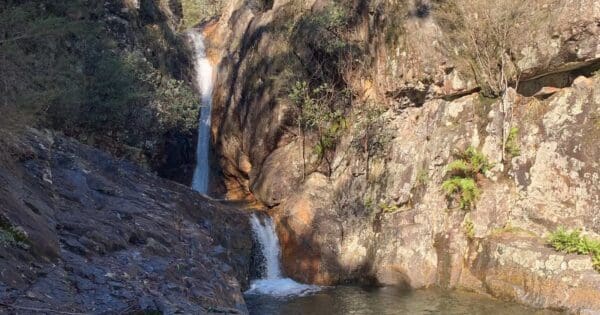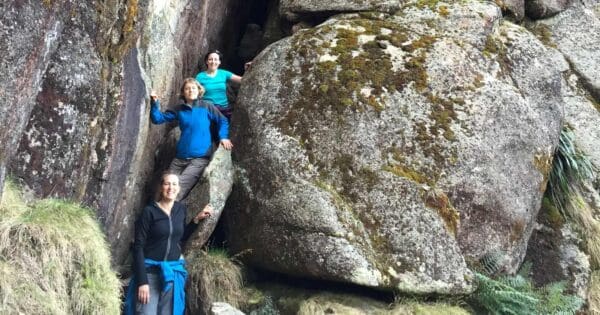Hike at a Glance
Max elevation: 569m
Min elevation: 453m
Total Ascent: 132m
Hike overview
Eurobin Falls is a picturesque 1.4-kilometre hike nestled in Mount Buffalo National Park, Victoria. The trail is rated Grade 3 and generally takes about 45 minutes to complete, making it an ideal outing for a half-day adventure. The hike begins at the stunning Ladies Bath Falls, where water flows into a crystal-clear pool. From there, the track continues to Lower Eurobin Falls, and a steeper section leads you up to the base of the Upper Falls, offering stunning views of Crystal Creek as it cascades dramatically over a towering granite escarpment.
The Falls, though not enormous in size, have played a significant role in shaping the landscape. The creek has carved a deep chasm at the top of Eurobin Falls, creating the striking natural feature visible from the trail. This area is a perfect place to take a break and enjoy the beauty of the surrounding environment. The falls are easily accessible, making it a popular spot for both locals and visitors, especially those staying in nearby Bright. The area also has a bit of history. In the early 20th century, the falls were a popular stop for travellers heading to the Mount Buffalo Chalet, with women often gathering at Ladies Bath to cool off in the refreshing waters of Crystal Brook while the men would take their break elsewhere.
While this spot is an excellent place to relax or enjoy a picnic, it's especially inviting during the summer months when the heat of the Ovens and Buckland valleys can make the cool waters a welcome respite. The walk is relatively short, so it’s easy to explore all three falls in one go.
However, visitors should be cautious when walking on the rocks around Ladies Bath, as they can be slippery, especially near the water's edge. Since this is a natural environment, there are always potential hazards, so it's important to stay safe around the falls. Following water safety advice will help ensure your visit to Eurobin Falls is both enjoyable and secure, allowing you to fully appreciate the tranquil beauty of this charming location.
Tips
- The trail features a steep climb along a well-maintained path with plenty of steps, so be prepared for some uphill sections.
- There are limited opportunities to swim at the Upper and Lower Falls, but Ladies Bath Falls offers a perfect spot for a refreshing dip.
- Be cautious, as the rocks can be slippery when wet, especially around the water's edge.
Track grade
Grade 3 (Moderate) - Walks for Most Fitness Levels: Grade 3 on the AWTGS represents moderate walking tracks. These are ideal for walkers with some fitness who are comfortable with some hills and uneven terrain. While suitable for most ages, some bushwalking experience is recommended to ensure a safe and enjoyable experience. Tracks may have short, steep hill sections, a rough surface, and many steps. The total distance of a Grade 3 walk can be up to 20 kilometers.
Walk map and GPX file
Max elevation: 569 m
Min elevation: 453 m
Total climbing: 132 m
Total descent: -132 m
Content use
Please don’t copy GPX files or content from this site to AllTrails or other platforms. Each trail has been personally mapped, documented, and refined to support Australia’s bushwalking and hiking community. While some details come from land managers, every listing reflects significant personal effort. This is a free, community-driven initiative—your respect helps keep it that way.
Getting there
Getting to the trailhead: Mount Buffalo National Park.
To reach the Eurobin Falls trailhead from Melbourne, travel northeast along the Hume Freeway (M31) for approximately 320 kilometres. Just past Glenrowan, take the exit onto Snow Road (C522) and head east. At the junction with the Great Alpine Road (B500), turn south towards Porepunkah. Upon reaching Porepunkah, turn left onto Mount Buffalo Road (C535) and continue for about 2.5 kilometres. The small car park for Eurobin Falls will be on your left, just after a sharp bend in the road. From the car park, the well-marked Eurobin Falls Track begins, leading you through lush forest to the falls.
Need a rental car to get you to the hike? Find one here.
About the region
Tucked into Victoria’s High Country, Mount Buffalo National Park is a place of striking contrasts and quiet beauty. Granite cliffs rise from the landscape, softened by forests of snow gum and alpine ash. Waterfalls tumble into fern-lined creeks, while the crisp mountain air carries the scent of eucalyptus. This land holds deep cultural significance for the Taungurung Traditional Owners, whose connection to Country continues today.
More than 90 kilometres of marked walking tracks wind through this diverse terrain, offering everything from short strolls to longer, more remote hikes. You’ll pass through mossy gullies, open plateaus, and wildflower-filled meadows. It’s essential to stay on designated trails and carry a physical map, as phone signal can be unreliable and the alpine environment is sensitive to disturbance.
There are plenty of picnic areas to enjoy, whether you're after wide-open views or quiet, shaded corners. The Gorge Day Visitor Area and The Horn provide sweeping lookouts, while Eurobin Creek and Rollasons Falls offer easy access to gentle waterfalls. Grossmans Mill and the Oval are more secluded, and the Lakeside Day Visitor Area near Lake Catani is perfect for warm days, with picnic tables, toilets, shelters, barbecues, and space to swim or paddle a canoe.
Camping allows for a deeper connection to the landscape. Lake Catani Campground, open November to April, includes hot showers and toilets. In winter, campers can access it on foot or skis, with basic facilities available. For a quieter, more rugged experience, Rocky Creek and Mount McLeod campgrounds offer remote camping with minimal amenities—bookings are required and can be made online or by calling Parks Victoria on 13 1963.
Since its establishment in 1898, this 31,000-hectare park has protected unique subalpine ecosystems. Signs of past bushfires are still visible, but regrowth is underway, with vibrant new life emerging. Wildlife is abundant—keep an eye out for lyrebirds, wombats, and wallabies, especially near the road at dawn and dusk. Whether you're here for a few hours or a few days, Mount Buffalo has a way of leaving a lasting impression on those who take the time to explore its quiet trails.
Find a place to stay
Wondering where to stay near this hike? Find accommodation close to the trailhead — hotels, cabins and campgrounds nearby. Click the button to view the interactive map.
Closest towns to this walk: Beechworth, Bright, Eurobin, Harrietville, Myrtleford, Ovens, Porepunkah, Tawonga South, Wandiligong, Wangaratta
Let someone know
Heading out? Fill in a trip intentions form so someone knows your plans. If things go wrong, they can raise the alarm fast, giving you peace of mind on the trail.
Similar walks nearby
Looking for more walks in or near Mount Buffalo National Park? Try these trails with a similar difficulty grade.
Suggest an edit
Notice something different about this trail? Whether it’s a new feature, a route change, or a closure, share your update so we can keep our info accurate and helpful for fellow hikers.
Click to suggest edits >>
Explore safe
Plan ahead and hike safely! Carry enough water, pack layers for changing conditions, and bring safety gear like a torch, PLB, and reliable communication device. Check official sources for trail updates, closures, and access requirements, and review local weather and bushfire advice. Most importantly, share your plans with someone before you go. Being prepared makes for a safer and more enjoyable hike! Stay Safe, Explore More, and Always #ExploreSafe.
Packing checklists
What you carry in your pack depends on factors like weather, terrain, and your adventure type. Not sure what to bring? My free planning, food, and packing checklists are a great starting point, covering day hikes, overnight trips, and multi-day adventures. Use them to customise your kit and always prioritise safety.
Acknowledgement of Country
Trail Hiking Australia acknowledges the Traditional Owners of the lands on which we hike and pay respects to their Elders, past and present, and we acknowledge the First Nations people of other communities who may be here today.
/Eurobin-Falls-Walk_8.jpg)
/Eurobin-Falls-Walk_6.jpg)
/Eurobin-Falls-Walk_11.jpg)
/Eurobin-Falls-Walk_5.jpg)
/Eurobin-Falls-Walk_14.jpg)
/Eurobin-Falls-Walk_12.jpg)
/Eurobin-Falls-Walk_3.jpg)
/Eurobin-Falls-Walk_10.jpg)
/Eurobin-Falls-Walk_7.jpg)
/Eurobin-Falls-Walk_1.jpg)
/Eurobin-Falls-Walk_2.jpg)
/Eurobin-Falls-Walk_13.jpg)
/Eurobin-Falls-Walk_15.jpg)
/Eurobin-Falls-Walk_4.jpg)
/Eurobin-Falls-Walk_9.jpg)






